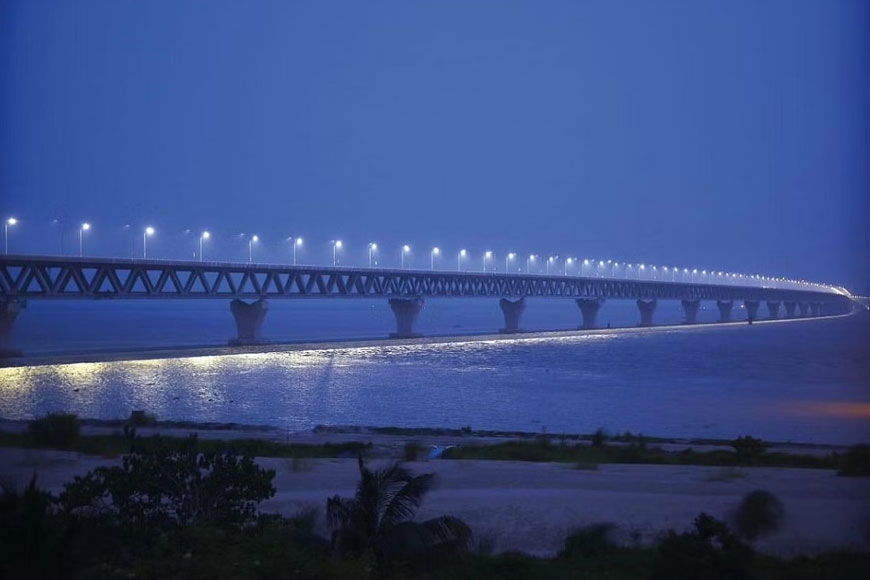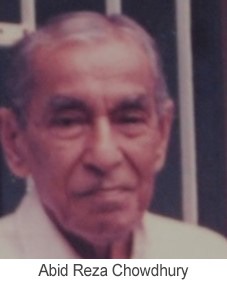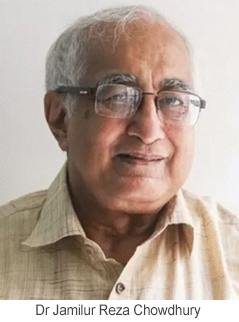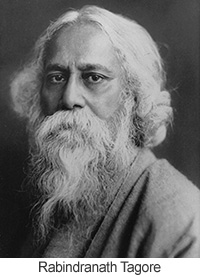Tale of the Padma bridge in Bangladesh

On June 25, Prime Minister Sheikh Hasina inaugurated the longest multipurpose bridge over the Padma River. This bridge marks an important milestone in independent Bangladesh’s history, as it is a symbol not just of Bangladesh’s resolve but of its growing economic capacity and development. The travel time to Dhaka is substantially lesser now.
 Is there a connection between the swanky Padma Bridge in Bangladesh that hits the world news around and Rabindranath Tagore? Well, yes there is! More than 100 years ago when the poet had refused to travel in the traditional way across the hills of Bangladesh being carried in a Palkhi or otherwise. This catapulted the British administration to construct a bridge across the inaccessible path between Shillong and Srihatta or today’s Sylhet. The engineering marvel was the brainchild of Abid Reza Chowdhury and hold your breath, his son, Bangladesh’s National Professor, Dr Jamilur Reza Chowdhury is the chief consultant for the construction of the present Padma Bridge. From engineering point of view, Padma Bridge was one of the most challenging projects in the world and new construction techniques had to be devised to cope with the unique geographical condition of the river. But this unification of different parts of East and West Bengal was long back thought of by poet himself and his dreams today come true, thanks to the talented father-son duo who succeeded in bridging the gap between places and people and help realize the poet’s ideal of unification through the two bridges they built in their own times.
Is there a connection between the swanky Padma Bridge in Bangladesh that hits the world news around and Rabindranath Tagore? Well, yes there is! More than 100 years ago when the poet had refused to travel in the traditional way across the hills of Bangladesh being carried in a Palkhi or otherwise. This catapulted the British administration to construct a bridge across the inaccessible path between Shillong and Srihatta or today’s Sylhet. The engineering marvel was the brainchild of Abid Reza Chowdhury and hold your breath, his son, Bangladesh’s National Professor, Dr Jamilur Reza Chowdhury is the chief consultant for the construction of the present Padma Bridge. From engineering point of view, Padma Bridge was one of the most challenging projects in the world and new construction techniques had to be devised to cope with the unique geographical condition of the river. But this unification of different parts of East and West Bengal was long back thought of by poet himself and his dreams today come true, thanks to the talented father-son duo who succeeded in bridging the gap between places and people and help realize the poet’s ideal of unification through the two bridges they built in their own times.
Bangladesh Prime Minister Sheikh Hasina ushered in a new dawn on June 25, 2022 when she inaugurated her dream project, the Padma Multipurpose Bridge, a two-level road-rail bridge across the Padma River. The longest bridge (6.15 kilometer-long) over the Padma River connects Shariatpur and Madaripur, linking the southwest of the country to the northern and eastern regions. The bridge will not only benefit about three crore people across 21 south-western districts of Bangladesh but will also decrease travel time between Dhaka and Kolkata.
 The completion of the Padma Bridge is a dream come true for the 170 million people in Bangladesh. The nation is agog with excitement as the bridge has opened up new vistas in all spheres of life including trade and business and travel and tourism. The name of Bengal’s Bard, Rabindranath Tagore also seems to be intrinsically linked with that bridge. The connection may be decades old, conceived during his lifetime but still, it was Tagore who kindled a latent fire to build the Padma Bridge. Professor Jamilur Reza Choudhury, the most eminent personality in engineering community of Bangladesh, who played a pivotal role in development of the infrastructure system of Bangladesh, was the head of the international panel of experts for Padma Multipurpose Bridge Project. He was an internationally recognized civil engineer, educationist, researcher, administrator and a leader who passed away on April 28, 2020, at the age of 76.
The completion of the Padma Bridge is a dream come true for the 170 million people in Bangladesh. The nation is agog with excitement as the bridge has opened up new vistas in all spheres of life including trade and business and travel and tourism. The name of Bengal’s Bard, Rabindranath Tagore also seems to be intrinsically linked with that bridge. The connection may be decades old, conceived during his lifetime but still, it was Tagore who kindled a latent fire to build the Padma Bridge. Professor Jamilur Reza Choudhury, the most eminent personality in engineering community of Bangladesh, who played a pivotal role in development of the infrastructure system of Bangladesh, was the head of the international panel of experts for Padma Multipurpose Bridge Project. He was an internationally recognized civil engineer, educationist, researcher, administrator and a leader who passed away on April 28, 2020, at the age of 76.
 In 1919, more than a century ago. Rabindranath Tagore visited Shillong. When locals heard of the Nobel Laureate’s visit to the town, people thronged to have a glimpse of the poet and many pleaded the poet to pay a visit to Srihatta (Sylhet). Shillong was then the capital of Assam and Sylhet was a district town, well-known for its diverse and rich heritage and culture. It was only four months since the poet renounced his Knighthood to protest against the mass massacre at Jalianwallah Bagh (he wrote the formal letter to Lord Chelmsford, the British Viceroy on May 30, 1919) and his bold decision had inspired people from all walks of life who literally worshipped him. Govinda Narayan Singha Majumder, general secretary of the Brahmo Samaj, Srihatta Chapter and heads of several social and cultural organizations, including the Shrihatta Mahila Samiti, sent a telegram to the poet requesting him to pay a visit to Shrihatta. The poet readily agreed. But there was no direct communication route between Shillong and Srihatta. People had to take a long and winding detour to travel due to lack of a concrete road. One had to go down the Khasia hills through Cherrapunji and Thariaghat to reach Srihatta. Till a certain part, the road was navigable and could be reached by automobiles but beyond that, the traveller would have to ride piggy back. This was a common mode of transport in the hilly regions in those days.
In 1919, more than a century ago. Rabindranath Tagore visited Shillong. When locals heard of the Nobel Laureate’s visit to the town, people thronged to have a glimpse of the poet and many pleaded the poet to pay a visit to Srihatta (Sylhet). Shillong was then the capital of Assam and Sylhet was a district town, well-known for its diverse and rich heritage and culture. It was only four months since the poet renounced his Knighthood to protest against the mass massacre at Jalianwallah Bagh (he wrote the formal letter to Lord Chelmsford, the British Viceroy on May 30, 1919) and his bold decision had inspired people from all walks of life who literally worshipped him. Govinda Narayan Singha Majumder, general secretary of the Brahmo Samaj, Srihatta Chapter and heads of several social and cultural organizations, including the Shrihatta Mahila Samiti, sent a telegram to the poet requesting him to pay a visit to Shrihatta. The poet readily agreed. But there was no direct communication route between Shillong and Srihatta. People had to take a long and winding detour to travel due to lack of a concrete road. One had to go down the Khasia hills through Cherrapunji and Thariaghat to reach Srihatta. Till a certain part, the road was navigable and could be reached by automobiles but beyond that, the traveller would have to ride piggy back. This was a common mode of transport in the hilly regions in those days.
Tagore was dead against being carried by a fellow human being like a beast of burden through the long and arduous path. He flatly refused to travel piggy back and instead offered to walk for 10 miles if that was an option. Finally, a very long route was chosen and Rabindranath reached Srihatta via Guwahati-Lamding-Badarpur-Kulaura. The poet’s stance shook the very foundation of the local administration. Soon, preliminary discussions started on the construction of Sylhet-Shillong direct road.
Basant Kumar Das of Buranga village in Srihatta, an influential Congress leader and minister at the time, took the initiative. But connecting the rocky Umgat River road and the Jayanthiya Hills was a virtually impossible task. At that time Abid Reza Chowdhury was called to find a solution to the stumbling block. Chowdhury was then working as a civil engineer in Shillong. He designed a special bridge and it was built in 1930 under his direction. This bridge was a necessity but none thought of it until the poet's refusal to use the traditional mode of travelling piggy back for miles through undulating hills and jungles. And today his son helps in building the historic Padma Bridge, one of the bridge wonders of the world.










